VF-11 "THUNDERBOLT"
VARIABLE FIGHTER
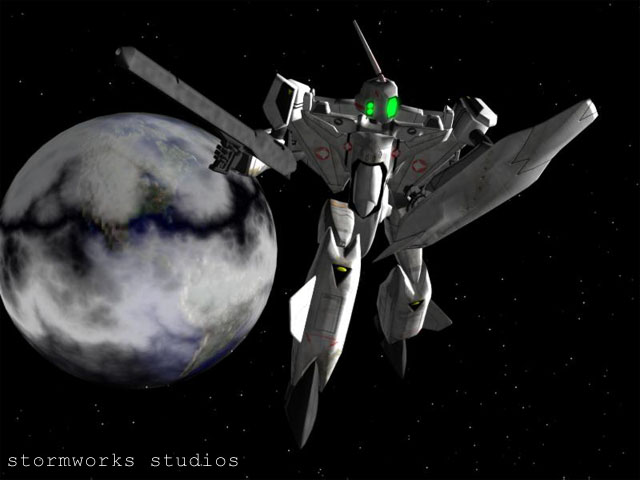
BACKGROUND
The VF-11 Thunderbolt is the standard tactical variable fighter
for the UN Spacy forces as of 2040. The mecha is a direct descendant of
the original VF-1 Valkyrie and has several design similarities to
the now-antique fighter, including variable soldier and gerwalk modes,
a head laser external gun pod, and optional add-on boosters for increased
range and maneuverability. The VF-11 replaced the older VF-4 Lightning
III as the UN Spacy's main combat mecha in 2030, and has been in service
now for almost a decade. Thunderbolts are found all over human-colonized
space, on long-distance colony ships, colonized planets, and deep space
military forces. The design is starting to become outdated, however, and
is scheduled to be replaced by the VF-19
Excalibur, the winning design of the Project Super Nova
competition. However, due to the large numbers of Thunderbolts stationed
all across the galaxy it will probably be several years yet before the
VF-19 can be produced in sufficient numbers to retire the VF-11 from service.
There is one interesting footnote in the development of the Thunderbolt.
During the early tests of the prototype VF-11s the addition of the forward
canard wings was a subject of great debate with the engineers and test
supervisors. Although the canards provided increased maneuverability for
the fighter, they also created additional aerodynamic drag which lowered
the top speed of the variable fighter in a planetary atmosphere. Despite
the drawbacks many of the test pilots were in favor of the canard wing,
including Captain Milia Jenius of the Eagle Nest Aerial Tactics
Center, who was involved in testing of the final VF-11 prototypes. The
event which clinched the decision to include the canard wings eventually
came when Captain Jenius piloted the VFX-11 prototype on a rescue mission
to save a UN chief advisor. The successful rescue of the individual and
the data collected from the prototype during the rescue operation led to
the decision to include the canard wing on the VF-11, as well as later
VFs designed by Shinshi Inudstries.
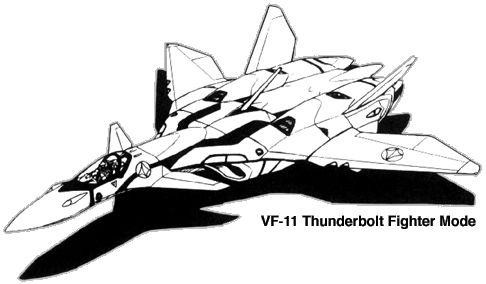
RPG STATS
Vehicle Types:
-
VF-11A: First manufactured version. Initially equipped with a shorter
barrel on the anti-aircraft laser and a dual-visor sensor system in the
head.
-
VF-11B: Standard UN Spacy version, circa 2040. Lengthened barrel
on the head anti-aircraft laser and redesigned single-visor sensor system.
-
VF-11C: Upgraded version of the VF-11B, featuring enhanced communication/navigation
systems. Fleet-wide upgrade of all VF-11B fighters to VF-11C versions begun
in 2040.
-
VF-11D: Two-seater version for training and recon operations.
-
VF-11D Jamming Bird Custom: Custom version produced on board the
Macross 7 colony fleet. Contains sound energy technology.
-
VF-11MAXL-Kai: Custom version produced on board the Macross 7
for Sound Force. Contains sound energy technology.
-
VF-11 Full Armor: Heavy armor variant of VF-11A, B, C, or D.
Class: Tactical Variable Fighter
Manufacturer: Shinsei Industries
Crew: One pilot wearing Tactical Life Support System
MDC BY LOCATION:
Head Laser 30
(1) Head 75
Hands (2) 50 each
Arms (2) 100 each
Legs & Thrusters (2) 200 each
(2) Main Body 300
Canard Forward Wings (2) 30 each
Main Wings (2) 120 each
Tails (2) 50 each
Multipurpose Gun Pod 100
Anti-Projectile Shield 150
Reinforced Pilot Compartment/Escape Pod 150
NOTES:
-
Destroying the head of the fighter will knock out the mecha's major sensor
systems, including all of the optics systems (infrared, nightvision, thermal).
Radar and communications will be unaffected.
-
Depleting the MDC of the main body will destroy the mecha. The pilot and
cockpit section/escape pod will be automatically ejected from the doomed
mecha before it explodes by the mecha's main computer.
SPEEDS:
-
RUNNING, SOLDIER CONFIGURATION:
-
90 mph (144 kmph)
-
LEAPING, SOLDIER CONFIGURATION:
-
30 ft (9 m) high or 50 ft (15.2 m) long without thrusters.
-
FLYING, SOLDIER CONFIGURATION:
-
300 mph (480 kmph) maximum speed limit in an Earth-like atmosphere. Can
also hover in place indefinitely.
-
FLYING, GERWALK CONFIGURATION:
-
Mach One (670 mph/1072 kmph) maximum speed limit in an Earth-like atmosphere.
Can also hover in place indefinitely.
-
FLYING, FIGHTER CONFIGURATION:
-
Mach 3.5+ (2345 mph/3752 kmph) max speed at 10,000 meters or less above
sea level. Mach 8.2+ (5494 mph/8790 kmph) max speed at 10,000-42,000 meters
above sea level. Max altitude of 42,000 meters without rocket booster assistance.
Maximum rate of ascent is 28,500 meters/minute. G limits are +22 to -14.5
standard Earth gravities.
-
MAX ENGINE THRUST:
-
28,000 kg x2 from main engines, plus 10,000 kg x4 from optional super booster
units or 120,000 kg x2 from optional solid-fuel rocket boosters.
STATISTICAL DATA:
-
HEIGHT:
-
41.34 ft (12.92 m) in soldier configuration.
-
22.05 ft (6.89 m) in gerwalk configuration.
-
15.39 ft (4.81 m) in fighter configuration.
-
WIDTH:
-
17.46 ft (5.45 m) at shoulders in soldier configuration.
-
35.84 ft (11.20 m) in gerwalk or fighter configuration with wings at maximum
extension.
-
LENGTH:
-
11.17 ft (3.49 m) in soldier configuration.
-
28.54 ft (8.92 m) in gerwalk configuration.
-
49.63 ft (15.51 m) in fighter configuration.
-
WEIGHT:
-
9000 kg.
-
PHYSICAL STRENGTH:
-
Equal to a P.S. of 50
-
CARGO:
-
Small compartment behind pilot's seat for personal belongings.
-
POWER PLANT:
-
Two Shinsei Industries/Pratt & Whitney/Rolls Royce FF-2025G thermonuclear
turbine engines. Several additional Pratt & Whitney HMM- 5B high-maneuverability
vernier thrusters for additional mobility are mounted at key positions
along the mecha's hull. Additional thruster options include paired super
booster units and added propellant storage or dual solid-fuel rocket boosters.
WEAPON SYSTEMS:
-
ANTI-AIRCRAFT PULSE LASER: The VF-11 mounts a single pulse laser
for use in air combat skirmishes and for defensive purposes. The laser
is mounted on the head of the mecha in soldier mode, and is located in
the central dorsal section of the main body pointed rearward in fighter
and gerwalk modes. The laser can only fire to the REAR of the fighter in
these modes; it cannot be turned to fire along another arc.
-
PRIMARY PURPOSE: Anti-aircraft
-
SECONDARY PURPOSE: Anti-missile/defensive
-
RANGE: 4000 feet (1200 m)
-
DAMAGE: 2D4 M.D.
-
RATE OF FIRE: The laser can be fired in rapid pulses up to 4 blasts
per round. A rapid fire blast counts as a burst of up to 4 shots.
-
PAYLOAD: Effectively Unlimited.
-
MULTIPURPOSE GUN POD W/ANTI-ARMOR BAYONET: A gun pod similar to
the old GU-11 used by the VF-1 Valkyries, this is the primary weapon of
the VF-11. The new gun pod also features a mecha-sized bayonet mounted
on the front of the weapon, for use in close combat with mechanized opponents.

-
PRIMARY PURPOSE: Assault
-
SECONDARY PURPOSE: Anti-mecha
-
RANGE: 4000 feet (1200 m)
-
DAMAGE: Does 4D6 M.D. for a short burst, 1D6x10 M.D. for a long
burst, or 2D6x10 M.D. for a full melee burst. Bayonet does 1D4x10 M.D.
per strike.
-
RATE OF FIRE: Equal to the number of combined attacks of the pilot.
-
PAYLOAD: 400 rounds per clip equals 40 short bursts, 20 long bursts,
or 10 full melee bursts. Additional ammo clips can be inserted, but exchanging
clips requires 2 melee actions. Two spare clips are stored behind the anti-projectile
shield.
-
WING HARD POINTS: Two fixed hard points are mounted on each wing
of the VF-11 for a total of 4 hardpoints on the fighter. These hardpoints
can be used to hold a variety of different ordinance types, including long,
medium, or short range missiles, or even the new medium-range high-maneuverability
(MRHM) missiles (after 2040). One long range, one MRHM, 3 medium range,
or 5 short range missiles can be mounted per hardpoint.
NOTE: Due to the location of the hard points, ALL missiles must
be fired or ejected before the VF-11 can convert into soldier mode. For
this reason the hard point missiles are usually fired within the first
few passes of an attack.
-
LONG RANGE MISSILES
-
Primary Purpose: Heavy Assault
-
Secondary Purpose: Anti-Spacecraft
-
Missile Types: Any type of standard UN Spacy Long Range Missile
can be used.
-
Range: Varies with missile type.
-
Damage: Varies with missile type.
-
Rate of Fire: Volleys of 1-4 missiles.
-
Payload: One per hardpoint; 4 maximum.
-
MEDIUM RANGE MISSILES
-
Primary Purpose: Assault
-
Secondary Purpose: Anti-Mecha
-
Missile Types: Any type of standard UN Spacy Medium Range Missile
can be used.
-
Range: Varies with missile type.
-
Damage: Varies with missile type.
-
Rate of Fire: 1-3 missiles per hardpoint.
-
Payload: Three per hardpoint; up to 12 maximum.
-
SHORT RANGE MISSILES
-
Primary Purpose: Assault
-
Secondary Purpose: Anti-Mecha
-
Missile Types: Any type of standard UN Spacy Short Range Missile
can be used.
-
Range: Varies with missile type.
-
Damage: Varies with missile type.
-
Rate of Fire: 1-5 missiles per hardpoint.
-
Payload: Five per hardpoint; up to 20 maximum.
-
MEDIUM RANGE HIGH MANEUVERABILITY MISSILES
-
Primary Purpose: Anti-Mecha
-
Secondary Purpose: Surgical Strikes
-
Mega-Damage: 2D6x10 M.D.
-
Rate of Fire: One per hardpoint.
-
Range: 80 miles.
-
Payload: One per hardpoint; 4 maximum.
-
Note: Not available prior to 2040.
-
HAND TO HAND COMBAT: If necessary, the pilot of the VF-11 can engage
in melee combat rather than use a weapon. The variable fighter is extremely
agile and can execute most typical hand to hand combat moves, such as punches,
jump kicks, leap attacks, rolling with impacts, etc.
DAMAGE:
-
Restrained Punch: 1D4 M.D.
-
Full Strength Punch: 2D6 M.D.
-
"Booster" Punch: 3D6 M.D. (counts as two attacks)
-
Tear or Pry with Hands: 1D6 M.D.
-
Kick: 1D6 M.D.
-
Leap Kick: 2D6 M.D.
-
Body Flip/Throw: 1D4 M.D.
-
Body Block/Tackle: 1D6 M.D.
-
Stomp: 1D6 M.D. (only effective against small objects)
STANDARD EQUIPMENT FOR THE VF-11:
-
ANTI-PROJECTILE SHIELD: A new addition to modern VFs, the VF-11
is equipped with an external shield that is mounted on the central rear
dorsal section of the mecha in fighter mode, and on the left arm in soldier
and gerwalk modes. On a successful parry in soldier or gerwalk mode, the
shield can be used to block missiles or projectiles, thus protecting the
main body from harm. Although constructed of super-strong materials, the
shield is NOT regenerable and must be ejected once its MDC is depleted.
-
AUTO-PILOT: The VF-11 is equipped with a computerized auto-pilot,
allowing the pilot to relax or even sleep during long voyages. The auto-
pilot can be programmed with a single destination or a complex flight plan
involving multiple speeds, directions, and destinations. The onboard computer
will alert the pilot when the fighter is near its destination, and can
also be set to automatically signal when sensors detect objects near the
mecha. The auto-pilot was designed with long intra-system space journeys
in mind.
-
COMBAT COMPUTER W/HUD DISPLAYS: The VF-11 is equipped with a combat
computer that can store and analyze data during combat with hostile forces.
The entire cockpit canopy of the VF-11 is a large HUD display, which allows
the computer to display large amounts of data to the pilot and even highlight
enemies and missile attacks with overlaid graphics. The combat computer
tracks and identifies specific enemy targets, and has a database of over
10,000 images stored in memory. The computer can identify and track up
to 250 targets simultaneously.
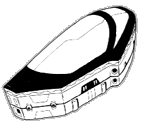
-
ESCAPE POD: The entire reinforced cockpit of the VF-11 is a detachable
escape pod that can be jettisoned when the mecha is destroyed. The ejected
cockpit does not contain thrusters, but does contain a powerful locator
beacon and an integrated life support system that can support the pilot
for up to 24 hours after ejection. The pod is also equipped with parachutes
in case of ejection in an atmosphere. The combat computer is programmed
to automatically eject the escape pod if the mecha is destroyed (main body
MDC reduced to 0), but this can be overridden if the pilot is feeling suicidal
for some reason.
-
EXTERNAL AUDIO PICKUP: Range: 300 ft (91.5 m). A sound amplification
system that can pick up normal conversation up to 300 feet away.
-
HEAT AND RADIATION SHIELDS: Special shielding prevents the penetration
of life threatening heat and radiation. A radiation detection and alarm
system are linked with the shields and will sound an alarm if there is
a rupture in the shields and what the levels of radiation are.
-
HOMING SIGNAL: The escape pod of the VF-11 is equipped with a homing
device that enables rescue teams to locate a disabled craft or ejected
life pod. The range of the signal is 400 miles (640 km). Most UN Spacy
ships and variable fighters can locate and track homing signals, and the
onboard computers will automatically notify their pilots if such a signal
is detected.
-
LASER TARGETING SYSTEM: Range: 100 miles (160 km). Used for increased
accuracy in the striking of enemy targets and is partly responsible for
the mecha's strike bonus.
-
LOUDSPEAKER: A loudspeaker system is built into the craft, which
can be used to amplify the pilot's voice up to 90 decibels.
-
OPTICS: INFRARED: Range: 2000 feet (610 m). This optical system
projects a beam of infrared light that is invisible to the normal eye,
but detectable by the mecha's sensors. The system allows the pilot to detect
hidden/concealed objects by their IR reflectiveness. The beam will be visible
to anyone with IR sensitive optics, however.
-
OPTICS: NIGHTVISION: Range: 2000 feet (610 m). A passive light image
intensifier that emits no light of its own, but relies on ambient light
which is electronically amplified to produce a visible picture.
-
OPTICS: THERMAL IMAGER: Range: 2000 feet (610 m). A passive optical
heat sensor that detects infrared radiation projected by warm objects and
converts that data into a false-color visible image. The system enables
the pilot to see in the dark, in shadows, and through smoke, and also adds
a +10% bonus to pilots using a tracking skill.
-
RADAR: 200 mile (321 km) range.
-
RADIO/VIDEO COMMUNICATION: Long range, directional communications
system with satellite relay capabilities. Range: 600 miles (960 km) or
can be boosted indefinitely via satellite relay.
-
SELF-DESTRUCT: To prevent capture of a variable fighter by the enemy,
the pilot can activate the VF-11's self-destruct system, which will cause
the fighter to explode after a delay of up to 60 minutes (time is set by
the pilot). The explosive damage is contained within a 20 foot (6 m) area
and inflicts 1D6x10 M.D. to everything within the radius of the explosion.
All internal systems are obliterated. The escape pod will be automatically
ejected prior to the explosion unless the pilot overrides the ejection
sequence.
-
STANDARD SURVIVAL KIT: All UN Spacy variable fighters come equipped
with a portable survival kit. Inside the small reinforced box is a medium-sized
flashlight, two hand flares, one rocket flare, a compass, infrared distancing
binoculars, a small mirror, a pocket knife, dehydrated and concentrated
food (can be stretched into a five day supply for one person) and basic
first aid items (aspirin, bandages, disinfectants, etc.)
-
TACTICAL LIFE SUPPORT SYSTEM: The VF-11's cockpit is pressurized,
and also provides additional air feeds to the pilot's flight suit that
provides him with pressurized breathing. The UN Spacy flight suit also
contains an upper and lower g-suit that promotes blood circulation even
during high-g turns, thus decreasing the possibility of pilot's blacking
out in combat.
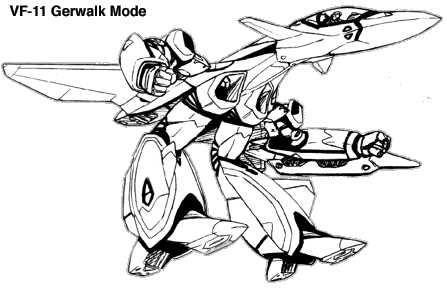
COMBAT BONUSES FOR THUNDERBOLT VF TRAINING:
BASIC VARIABLE FIGHTER COMBAT TRAINING
-
Basic training for non-pilot military personnel.
-
1 attack per melee (plus those of the pilot).
-
Add one additional action/attack at levels three, nine, and fifteen.
-
+1 on initiative.
-
+1 to strike.
-
+1 to parry
-
+1 to dodge in soldier mode, +3 in gerwalk, +5 in jet mode.
-
+1 to roll with a punch or fall with an impact, reducing damage by half.
-
No leap dodge.
-
No leap kick.
-
Critical strike same as pilot's hand-to-hand.
-
Body block/tackle/ram - 1D6 M.D. plus a 50% chance of knocking an opponent
down, causing him to loose initiative and one attack that melee round.
ADVANCED VF-11 THUNDERBOLT COMBAT TRAINING
-
Advanced training for pilots specializing in the VF-11.
-
3 attacks per melee (plus those of the pilot).
-
Add one additional action/attack at levels three, six, eleven, and fifteen.
-
+2 on initiative.
-
+2 to strike
-
+3 to parry
-
+2 to dodge in solder mode, +4 in gerwalk, +6 in jet mode.
-
+3 to roll with a punch or fall with an impact, reducing damage by half.
-
+2 to leap dodge. A leap dodge is an automatic dodge which causes no loss
of attacks per melee. The new generation variable fighters are so maneuverable
that the pilot can dodge an attack while moving to counterattack an enemy.
-
Critical strike same as pilot's hand-to-hand.
-
Body block/tackle/ram - 1D6 M.D. plus a 50% chance of knocking an opponent
down, causing him to loose initiative and one attack that melee round.
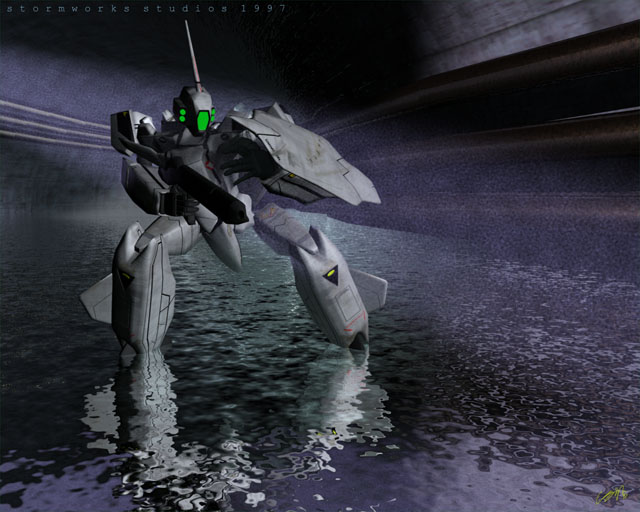
FICTIONAL BACKGROUND FOR ROBOTECH CAMPAIGNS:
The departure of the Robotech Expeditionary Forces in 2022 left a large
gap in the military power of Earth's defense forces. The REF took a very
large percentage of available combat mecha in service with Terran forces
at that time, including almost all VF-1, VAF-6, and VBF-1 veritechs that
had been produced to date. The removal of these fighters left the armies
of the Southern Cross without a medium-weight veritech fighter, forcing
them to rely on the lighter Logan veritechs and outdated non-transformable
fighters to fill the roles normally handled by VF-1 and VAF-6 Veritechs.
The Southern Cross requested development of a high-performance variable
combat fighter to replace the VF-1 and VAF-6 veritechs, and awarded the
contract to produce such a fighter to Shinsei Industries, a new development
firm based in rebuilt Japan. In 2025, Shinsei unveiled the VF-11 "THUNDERBOLT"
VERITECH. The Thunderbolt was approved by the Southern Cross and quickly
became a popular mecha among the TAF and TASC armies.
The VF-11 was designed by some of the same people who had worked on
the VF-1 Veritechs aboard the SDF-1 during the First Robotech War, and
thus shares many stylistic and functional features with its predecessor.
The swing-wing fighter configuration, variable guardian and battloid modes,
head laser, and gatling gun pod are all derived from the original VF-1
Veritech designs. However, part of the Southern Cross' design contract
specified that the new mecha was NOT to use protoculture in any way, shape,
or form. The limited amounts of protoculture available on Earth made it
unfeasible to equip common military mecha with protoculture systems. Thus
the Shinsei Industries design team built the VF-11 around the new FF-2025G
thermonuclear turbine engines; non-protoculture versions of the FF-2001
engines used in the VF-1 series. Advances in propulsion technology allowed
the newer engines to be even more efficient than the older versions. Shinsei
also produced several optional add-on systems for the VF-11, including
solid-fuel rocket boosters, new super boosters similar to the one used
on the VF-1 Super Veritechs, and heavy external armor with missile launchers
for an optional VF-11 Heavy Armor variant.
The armament systems of the VF-11 were similar to the VF-1. The Thunderbolt's
main weapon was a 65mm multipurpose gun pod with anti-armor bayonet, that
could be used in all modes by the Veritech. Descended from the GU-11, the
new gun pod offered a greater punch and a larger magazine capacity than
its predecessor. The multiple head lasers on the VF-1 were replaced with
a single pulse laser on the VF-11, which could cause greater damage than
the older lasers were capable of. The laser was mounted facing rear instead
of front in fighter and guardian modes, allowing the mecha to snipe at
missiles or enemy mecha that strayed behind the craft. Finally, in accordance
with Southern Cross mecha policy the VF-11 was equipped with a shield on
its left arm, which could be used to parry incoming weapons and increase
the defensive capabilities of the mecha.
The VF-11 Thunderbolt was produced in fair numbers up until 2030, when
they began to be replaced by the new AJACS Veritech Attack Copters. Thunderbolts
still served along with Logans in the TAF, however, and were commonly used
in land based conflicts with Malcontents, EBSIS, and Merchant Republic
forces. When the Robotech Masters finally arrived at Earth in 2032, the
Thunderbolts led the initial charge against the invaders for the Southern
Cross. Although the Second Robotech War only lasted a year, many VF-11s
were lost to heavier- armored Bioroid Transports used by the Masters. A
fair number of Thunderbolts did survive the war, however, and could still
be found in service with the remains of the Southern Cross and other fraction
nations during the chaos of 2032-2035. Even the Invid Invasion of 2035
did not stomp out the VF-11 entirely, as at least a dozen fighters have
been reported seen in operation with various resistance groups. However,
lack of parts and the arrival of newer, more advanced Veritech Alpha Fighters
means that it may not be long before the VF-11 Thunderbolt disappears altogether
from active service.







